NMS3201 Clinical Update Report: Understanding Osteoarthritis
VerifiedAdded on 2022/09/08
|18
|4084
|16
Report
AI Summary
This report provides a comprehensive clinical update on Osteoarthritis (OA), a prevalent form of arthritis characterized by cartilage erosion leading to joint pain and inflammation. The report delves into the etiology and pathogenesis of OA, exploring risk factors such as age, obesity, and genetics. It examines the physiological changes associated with the disease, including bone alterations and the formation of osteophytes and cysts. The clinical manifestations, including pain, stiffness, and reduced mobility, are discussed, along with diagnostic processes like physical and radiological examinations. Furthermore, the report outlines pharmacological treatment options, including medications like acetaminophen, NSAIDs, and opiates, and their associated benefits and complications. The impact of OA on public health, including its economic and psychological effects, is also addressed, offering a complete overview of the disease and its management.
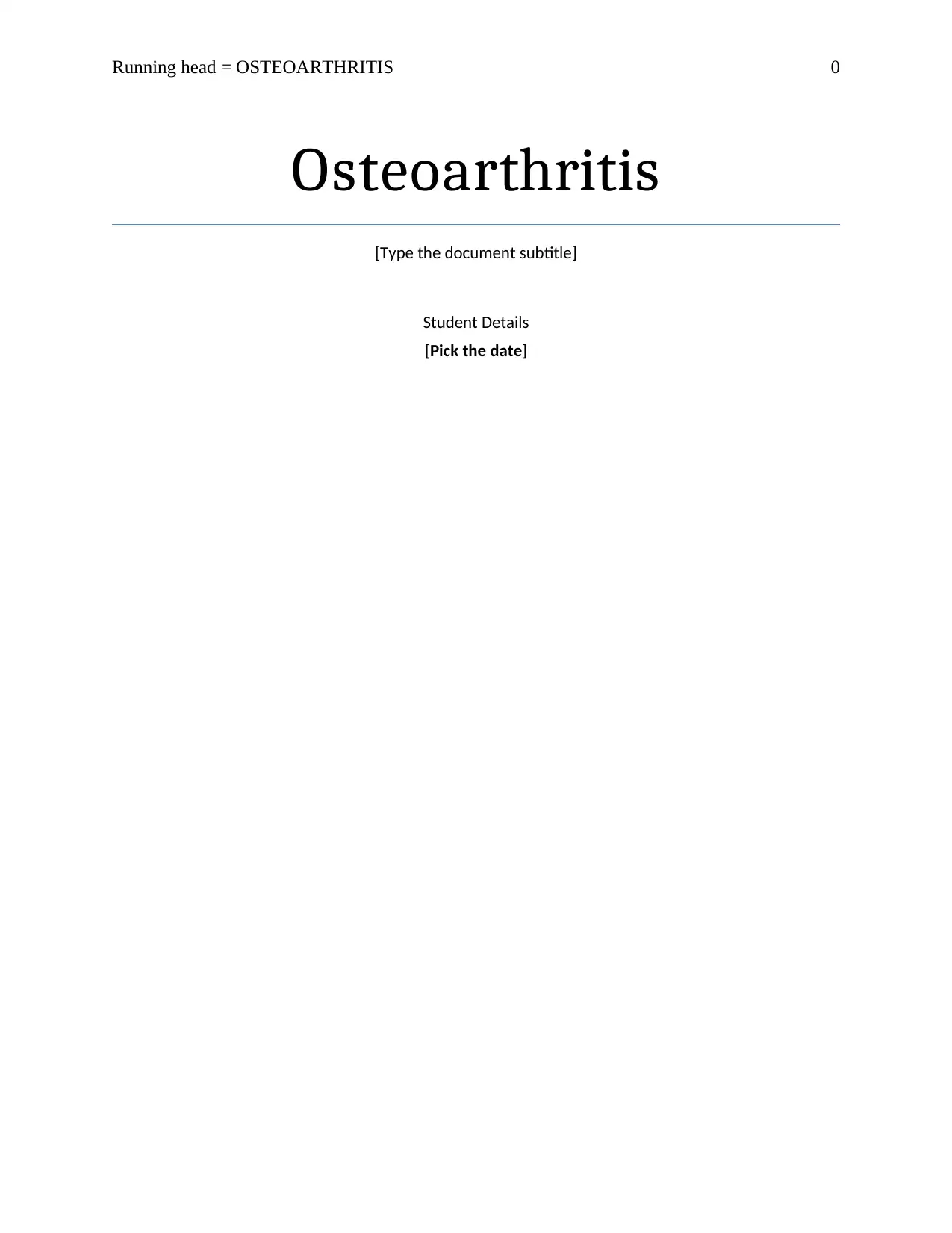
Running head = OSTEOARTHRITIS 0
Osteoarthritis
[Type the document subtitle]
Student Details
[Pick the date]
Osteoarthritis
[Type the document subtitle]
Student Details
[Pick the date]
Paraphrase This Document
Need a fresh take? Get an instant paraphrase of this document with our AI Paraphraser
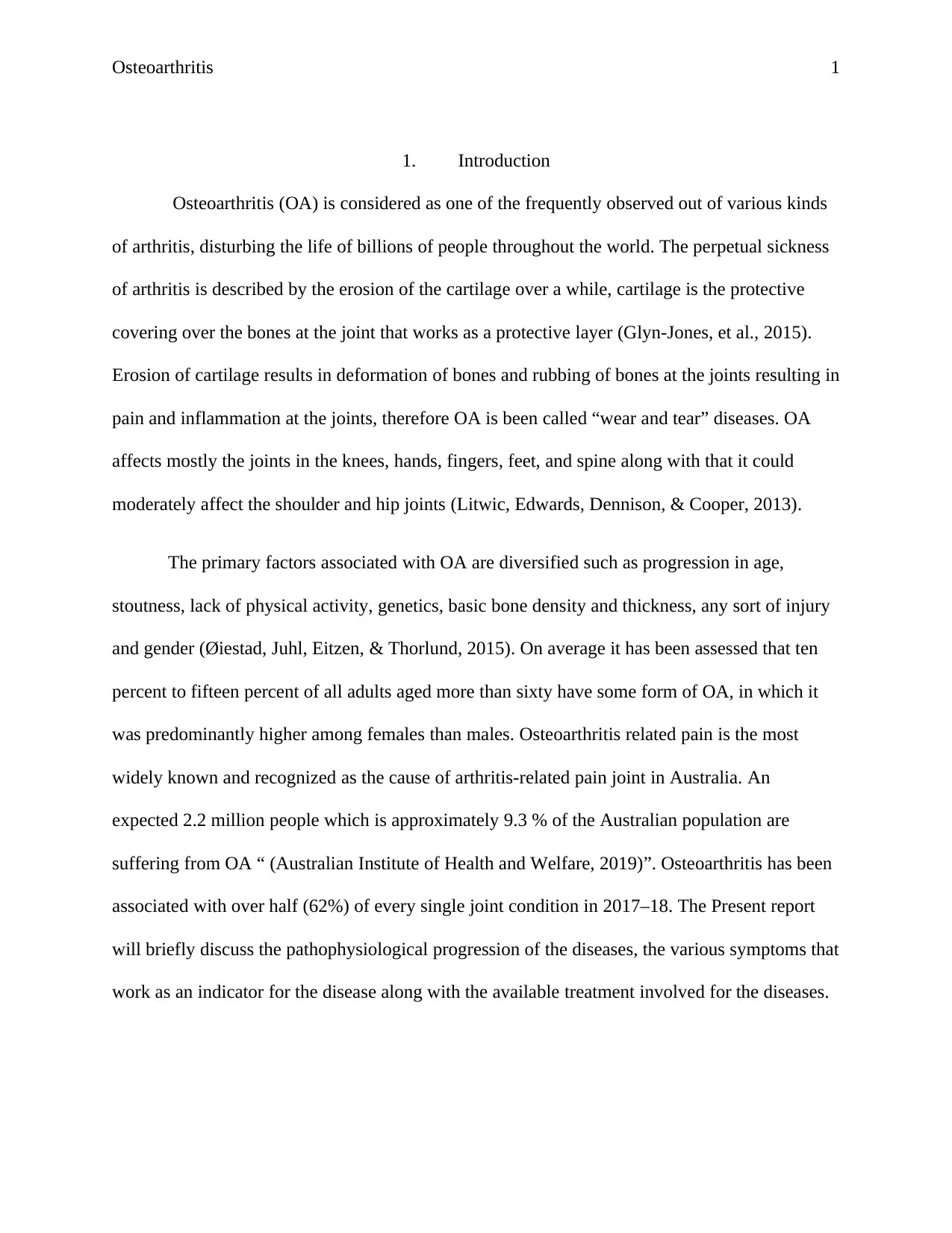
Osteoarthritis 1
1. Introduction
Osteoarthritis (OA) is considered as one of the frequently observed out of various kinds
of arthritis, disturbing the life of billions of people throughout the world. The perpetual sickness
of arthritis is described by the erosion of the cartilage over a while, cartilage is the protective
covering over the bones at the joint that works as a protective layer (Glyn-Jones, et al., 2015).
Erosion of cartilage results in deformation of bones and rubbing of bones at the joints resulting in
pain and inflammation at the joints, therefore OA is been called “wear and tear” diseases. OA
affects mostly the joints in the knees, hands, fingers, feet, and spine along with that it could
moderately affect the shoulder and hip joints (Litwic, Edwards, Dennison, & Cooper, 2013).
The primary factors associated with OA are diversified such as progression in age,
stoutness, lack of physical activity, genetics, basic bone density and thickness, any sort of injury
and gender (Øiestad, Juhl, Eitzen, & Thorlund, 2015). On average it has been assessed that ten
percent to fifteen percent of all adults aged more than sixty have some form of OA, in which it
was predominantly higher among females than males. Osteoarthritis related pain is the most
widely known and recognized as the cause of arthritis-related pain joint in Australia. An
expected 2.2 million people which is approximately 9.3 % of the Australian population are
suffering from OA “ (Australian Institute of Health and Welfare, 2019)”. Osteoarthritis has been
associated with over half (62%) of every single joint condition in 2017–18. The Present report
will briefly discuss the pathophysiological progression of the diseases, the various symptoms that
work as an indicator for the disease along with the available treatment involved for the diseases.
1. Introduction
Osteoarthritis (OA) is considered as one of the frequently observed out of various kinds
of arthritis, disturbing the life of billions of people throughout the world. The perpetual sickness
of arthritis is described by the erosion of the cartilage over a while, cartilage is the protective
covering over the bones at the joint that works as a protective layer (Glyn-Jones, et al., 2015).
Erosion of cartilage results in deformation of bones and rubbing of bones at the joints resulting in
pain and inflammation at the joints, therefore OA is been called “wear and tear” diseases. OA
affects mostly the joints in the knees, hands, fingers, feet, and spine along with that it could
moderately affect the shoulder and hip joints (Litwic, Edwards, Dennison, & Cooper, 2013).
The primary factors associated with OA are diversified such as progression in age,
stoutness, lack of physical activity, genetics, basic bone density and thickness, any sort of injury
and gender (Øiestad, Juhl, Eitzen, & Thorlund, 2015). On average it has been assessed that ten
percent to fifteen percent of all adults aged more than sixty have some form of OA, in which it
was predominantly higher among females than males. Osteoarthritis related pain is the most
widely known and recognized as the cause of arthritis-related pain joint in Australia. An
expected 2.2 million people which is approximately 9.3 % of the Australian population are
suffering from OA “ (Australian Institute of Health and Welfare, 2019)”. Osteoarthritis has been
associated with over half (62%) of every single joint condition in 2017–18. The Present report
will briefly discuss the pathophysiological progression of the diseases, the various symptoms that
work as an indicator for the disease along with the available treatment involved for the diseases.
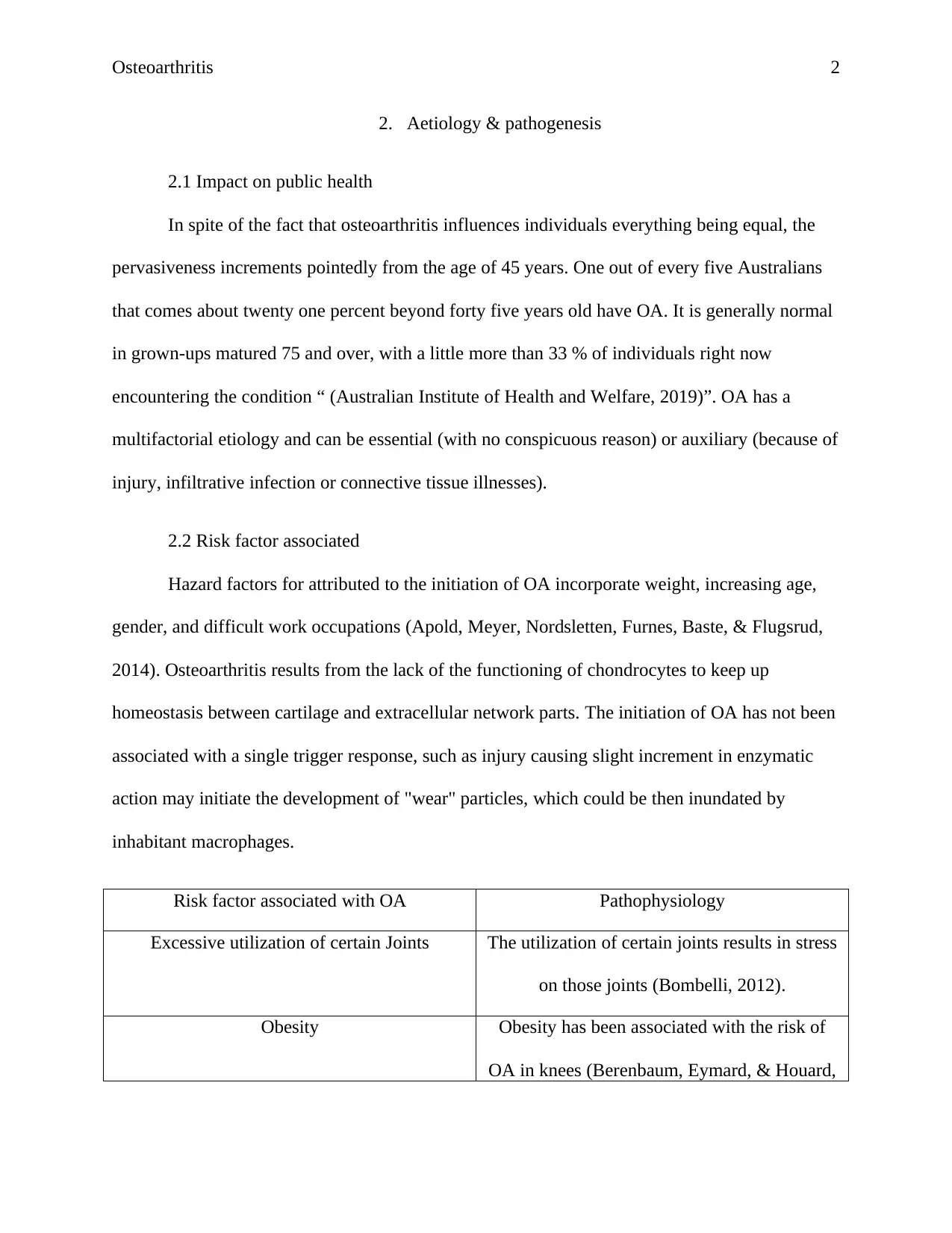
Osteoarthritis 2
2. Aetiology & pathogenesis
2.1 Impact on public health
In spite of the fact that osteoarthritis influences individuals everything being equal, the
pervasiveness increments pointedly from the age of 45 years. One out of every five Australians
that comes about twenty one percent beyond forty five years old have OA. It is generally normal
in grown-ups matured 75 and over, with a little more than 33 % of individuals right now
encountering the condition “ (Australian Institute of Health and Welfare, 2019)”. OA has a
multifactorial etiology and can be essential (with no conspicuous reason) or auxiliary (because of
injury, infiltrative infection or connective tissue illnesses).
2.2 Risk factor associated
Hazard factors for attributed to the initiation of OA incorporate weight, increasing age,
gender, and difficult work occupations (Apold, Meyer, Nordsletten, Furnes, Baste, & Flugsrud,
2014). Osteoarthritis results from the lack of the functioning of chondrocytes to keep up
homeostasis between cartilage and extracellular network parts. The initiation of OA has not been
associated with a single trigger response, such as injury causing slight increment in enzymatic
action may initiate the development of "wear" particles, which could be then inundated by
inhabitant macrophages.
Risk factor associated with OA Pathophysiology
Excessive utilization of certain Joints The utilization of certain joints results in stress
on those joints (Bombelli, 2012).
Obesity Obesity has been associated with the risk of
OA in knees (Berenbaum, Eymard, & Houard,
2. Aetiology & pathogenesis
2.1 Impact on public health
In spite of the fact that osteoarthritis influences individuals everything being equal, the
pervasiveness increments pointedly from the age of 45 years. One out of every five Australians
that comes about twenty one percent beyond forty five years old have OA. It is generally normal
in grown-ups matured 75 and over, with a little more than 33 % of individuals right now
encountering the condition “ (Australian Institute of Health and Welfare, 2019)”. OA has a
multifactorial etiology and can be essential (with no conspicuous reason) or auxiliary (because of
injury, infiltrative infection or connective tissue illnesses).
2.2 Risk factor associated
Hazard factors for attributed to the initiation of OA incorporate weight, increasing age,
gender, and difficult work occupations (Apold, Meyer, Nordsletten, Furnes, Baste, & Flugsrud,
2014). Osteoarthritis results from the lack of the functioning of chondrocytes to keep up
homeostasis between cartilage and extracellular network parts. The initiation of OA has not been
associated with a single trigger response, such as injury causing slight increment in enzymatic
action may initiate the development of "wear" particles, which could be then inundated by
inhabitant macrophages.
Risk factor associated with OA Pathophysiology
Excessive utilization of certain Joints The utilization of certain joints results in stress
on those joints (Bombelli, 2012).
Obesity Obesity has been associated with the risk of
OA in knees (Berenbaum, Eymard, & Houard,
⊘ This is a preview!⊘
Do you want full access?
Subscribe today to unlock all pages.

Trusted by 1+ million students worldwide
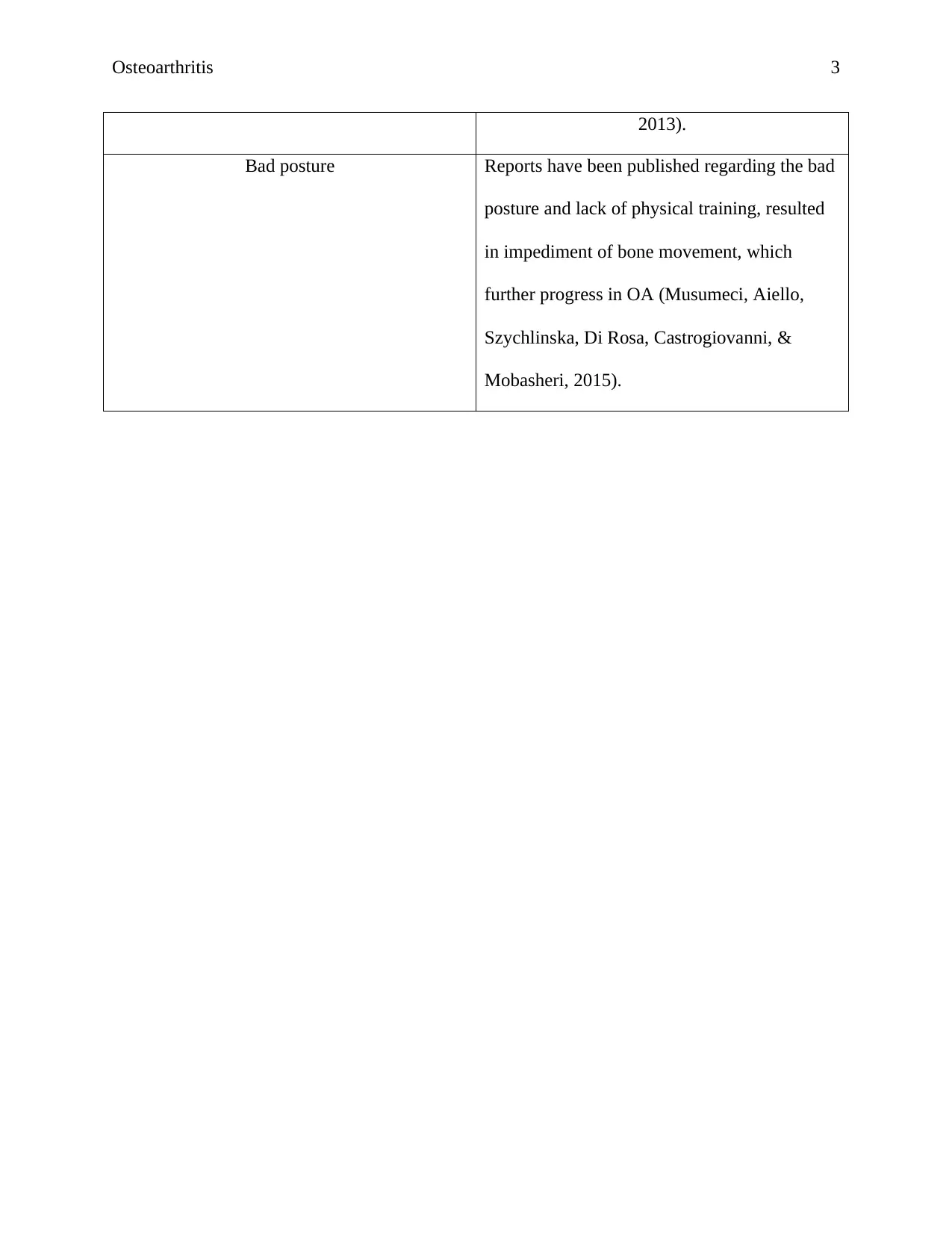
Osteoarthritis 3
2013).
Bad posture Reports have been published regarding the bad
posture and lack of physical training, resulted
in impediment of bone movement, which
further progress in OA (Musumeci, Aiello,
Szychlinska, Di Rosa, Castrogiovanni, &
Mobasheri, 2015).
2013).
Bad posture Reports have been published regarding the bad
posture and lack of physical training, resulted
in impediment of bone movement, which
further progress in OA (Musumeci, Aiello,
Szychlinska, Di Rosa, Castrogiovanni, &
Mobasheri, 2015).
Paraphrase This Document
Need a fresh take? Get an instant paraphrase of this document with our AI Paraphraser
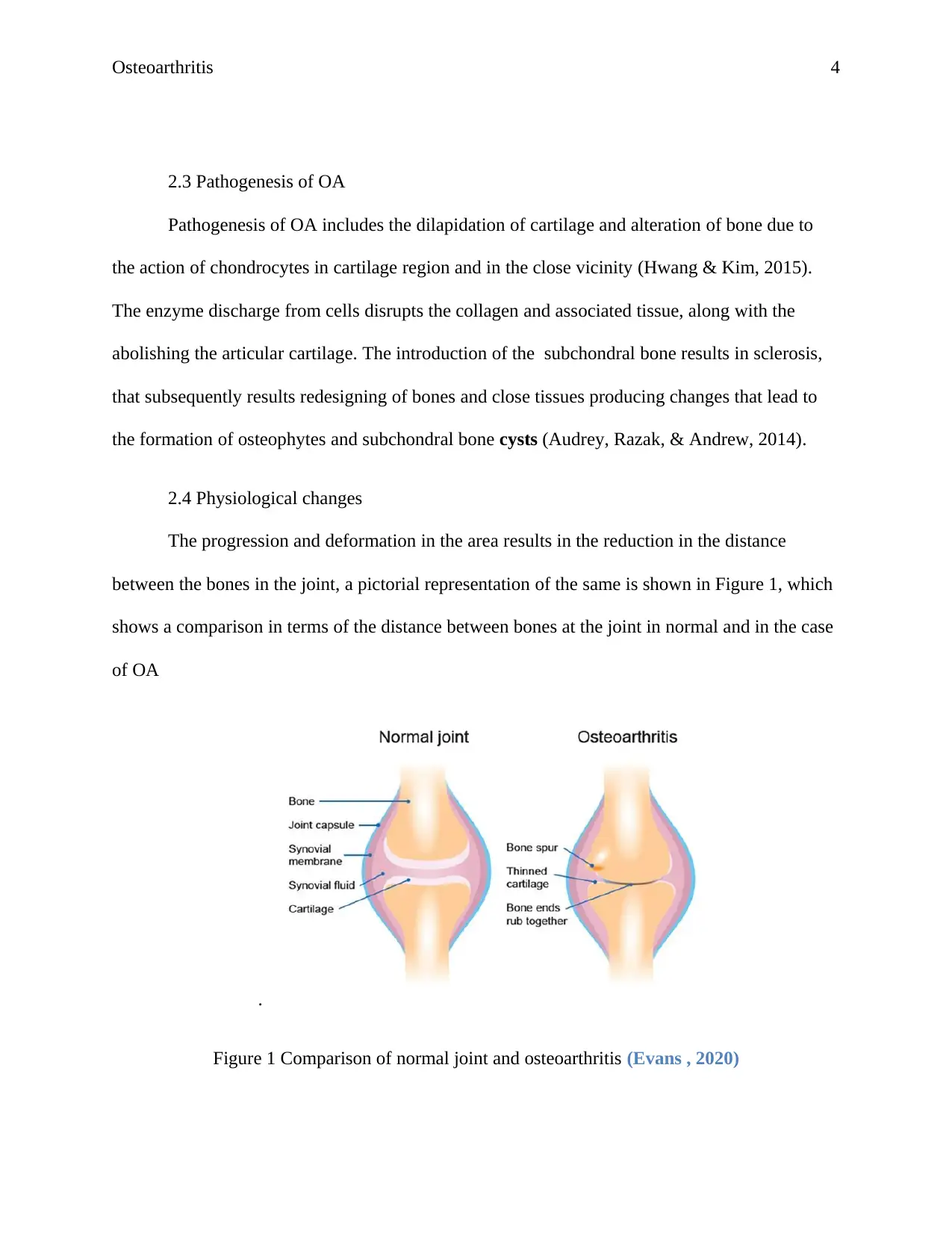
Osteoarthritis 4
2.3 Pathogenesis of OA
Pathogenesis of OA includes the dilapidation of cartilage and alteration of bone due to
the action of chondrocytes in cartilage region and in the close vicinity (Hwang & Kim, 2015).
The enzyme discharge from cells disrupts the collagen and associated tissue, along with the
abolishing the articular cartilage. The introduction of the subchondral bone results in sclerosis,
that subsequently results redesigning of bones and close tissues producing changes that lead to
the formation of osteophytes and subchondral bone cysts (Audrey, Razak, & Andrew, 2014).
2.4 Physiological changes
The progression and deformation in the area results in the reduction in the distance
between the bones in the joint, a pictorial representation of the same is shown in Figure 1, which
shows a comparison in terms of the distance between bones at the joint in normal and in the case
of OA
.
Figure 1 Comparison of normal joint and osteoarthritis (Evans , 2020)
2.3 Pathogenesis of OA
Pathogenesis of OA includes the dilapidation of cartilage and alteration of bone due to
the action of chondrocytes in cartilage region and in the close vicinity (Hwang & Kim, 2015).
The enzyme discharge from cells disrupts the collagen and associated tissue, along with the
abolishing the articular cartilage. The introduction of the subchondral bone results in sclerosis,
that subsequently results redesigning of bones and close tissues producing changes that lead to
the formation of osteophytes and subchondral bone cysts (Audrey, Razak, & Andrew, 2014).
2.4 Physiological changes
The progression and deformation in the area results in the reduction in the distance
between the bones in the joint, a pictorial representation of the same is shown in Figure 1, which
shows a comparison in terms of the distance between bones at the joint in normal and in the case
of OA
.
Figure 1 Comparison of normal joint and osteoarthritis (Evans , 2020)
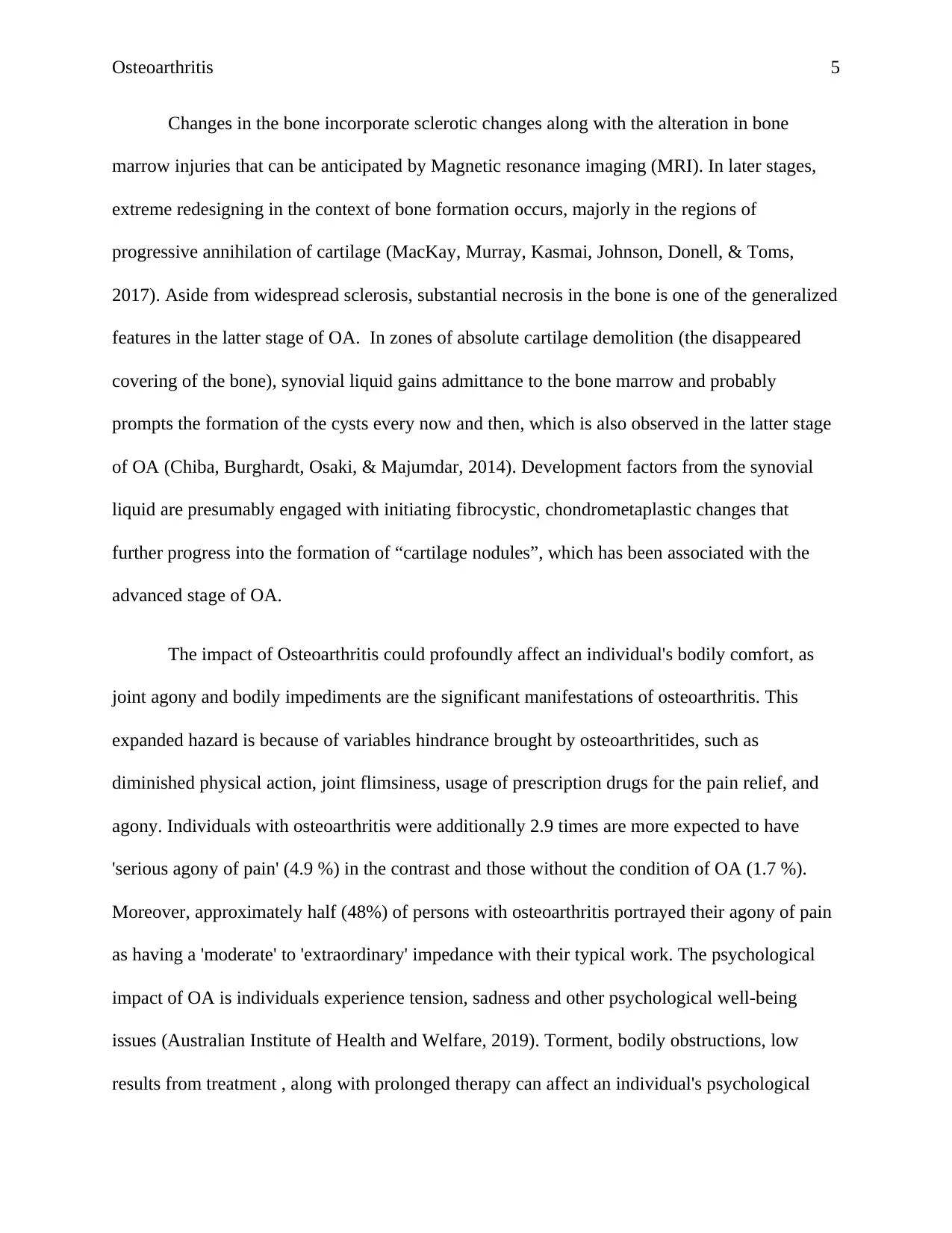
Osteoarthritis 5
Changes in the bone incorporate sclerotic changes along with the alteration in bone
marrow injuries that can be anticipated by Magnetic resonance imaging (MRI). In later stages,
extreme redesigning in the context of bone formation occurs, majorly in the regions of
progressive annihilation of cartilage (MacKay, Murray, Kasmai, Johnson, Donell, & Toms,
2017). Aside from widespread sclerosis, substantial necrosis in the bone is one of the generalized
features in the latter stage of OA. In zones of absolute cartilage demolition (the disappeared
covering of the bone), synovial liquid gains admittance to the bone marrow and probably
prompts the formation of the cysts every now and then, which is also observed in the latter stage
of OA (Chiba, Burghardt, Osaki, & Majumdar, 2014). Development factors from the synovial
liquid are presumably engaged with initiating fibrocystic, chondrometaplastic changes that
further progress into the formation of “cartilage nodules”, which has been associated with the
advanced stage of OA.
The impact of Osteoarthritis could profoundly affect an individual's bodily comfort, as
joint agony and bodily impediments are the significant manifestations of osteoarthritis. This
expanded hazard is because of variables hindrance brought by osteoarthritides, such as
diminished physical action, joint flimsiness, usage of prescription drugs for the pain relief, and
agony. Individuals with osteoarthritis were additionally 2.9 times are more expected to have
'serious agony of pain' (4.9 %) in the contrast and those without the condition of OA (1.7 %).
Moreover, approximately half (48%) of persons with osteoarthritis portrayed their agony of pain
as having a 'moderate' to 'extraordinary' impedance with their typical work. The psychological
impact of OA is individuals experience tension, sadness and other psychological well-being
issues (Australian Institute of Health and Welfare, 2019). Torment, bodily obstructions, low
results from treatment , along with prolonged therapy can affect an individual's psychological
Changes in the bone incorporate sclerotic changes along with the alteration in bone
marrow injuries that can be anticipated by Magnetic resonance imaging (MRI). In later stages,
extreme redesigning in the context of bone formation occurs, majorly in the regions of
progressive annihilation of cartilage (MacKay, Murray, Kasmai, Johnson, Donell, & Toms,
2017). Aside from widespread sclerosis, substantial necrosis in the bone is one of the generalized
features in the latter stage of OA. In zones of absolute cartilage demolition (the disappeared
covering of the bone), synovial liquid gains admittance to the bone marrow and probably
prompts the formation of the cysts every now and then, which is also observed in the latter stage
of OA (Chiba, Burghardt, Osaki, & Majumdar, 2014). Development factors from the synovial
liquid are presumably engaged with initiating fibrocystic, chondrometaplastic changes that
further progress into the formation of “cartilage nodules”, which has been associated with the
advanced stage of OA.
The impact of Osteoarthritis could profoundly affect an individual's bodily comfort, as
joint agony and bodily impediments are the significant manifestations of osteoarthritis. This
expanded hazard is because of variables hindrance brought by osteoarthritides, such as
diminished physical action, joint flimsiness, usage of prescription drugs for the pain relief, and
agony. Individuals with osteoarthritis were additionally 2.9 times are more expected to have
'serious agony of pain' (4.9 %) in the contrast and those without the condition of OA (1.7 %).
Moreover, approximately half (48%) of persons with osteoarthritis portrayed their agony of pain
as having a 'moderate' to 'extraordinary' impedance with their typical work. The psychological
impact of OA is individuals experience tension, sadness and other psychological well-being
issues (Australian Institute of Health and Welfare, 2019). Torment, bodily obstructions, low
results from treatment , along with prolonged therapy can affect an individual's psychological
⊘ This is a preview!⊘
Do you want full access?
Subscribe today to unlock all pages.

Trusted by 1+ million students worldwide
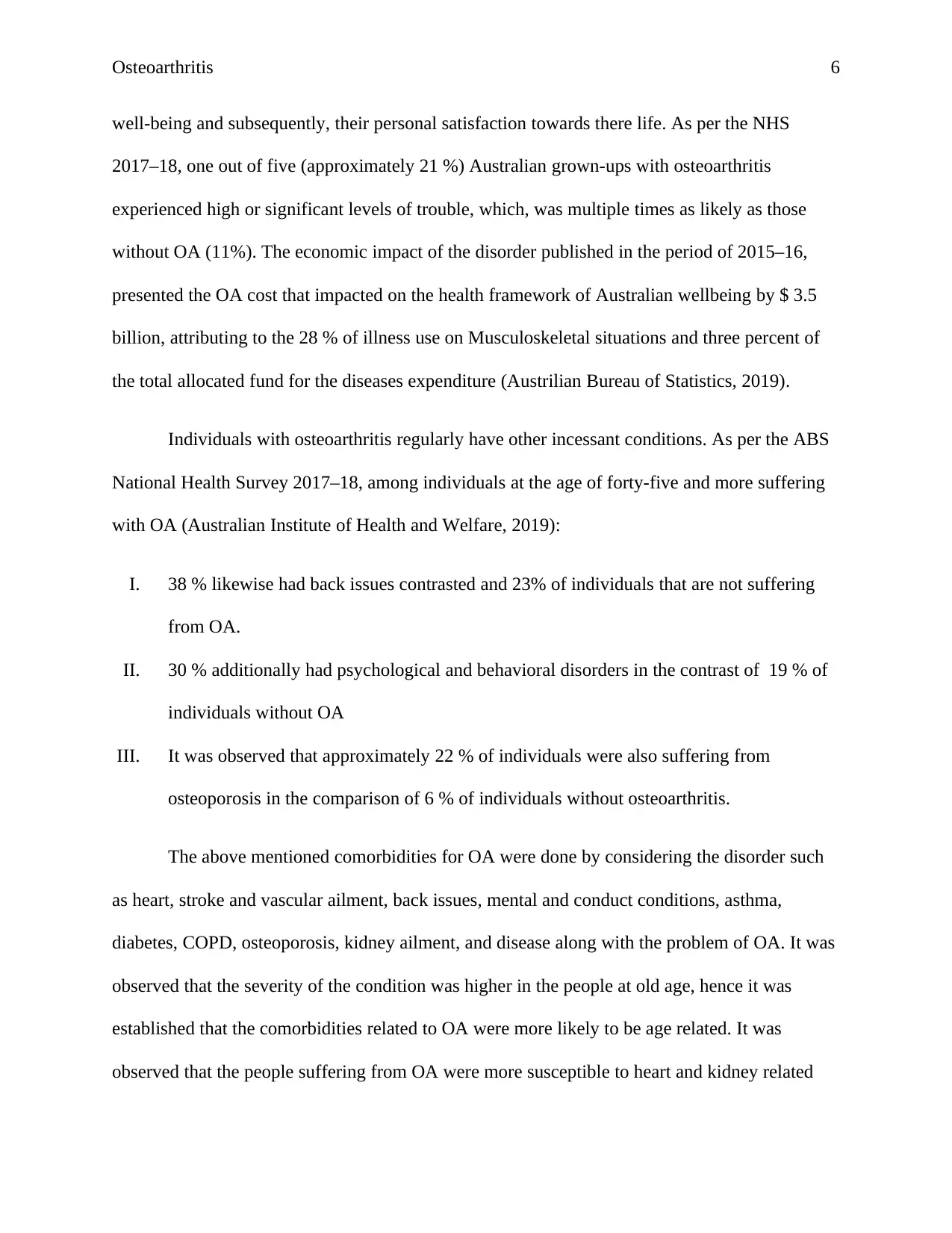
Osteoarthritis 6
well-being and subsequently, their personal satisfaction towards there life. As per the NHS
2017–18, one out of five (approximately 21 %) Australian grown-ups with osteoarthritis
experienced high or significant levels of trouble, which, was multiple times as likely as those
without OA (11%). The economic impact of the disorder published in the period of 2015–16,
presented the OA cost that impacted on the health framework of Australian wellbeing by $ 3.5
billion, attributing to the 28 % of illness use on Musculoskeletal situations and three percent of
the total allocated fund for the diseases expenditure (Austrilian Bureau of Statistics, 2019).
Individuals with osteoarthritis regularly have other incessant conditions. As per the ABS
National Health Survey 2017–18, among individuals at the age of forty-five and more suffering
with OA (Australian Institute of Health and Welfare, 2019):
I. 38 % likewise had back issues contrasted and 23% of individuals that are not suffering
from OA.
II. 30 % additionally had psychological and behavioral disorders in the contrast of 19 % of
individuals without OA
III. It was observed that approximately 22 % of individuals were also suffering from
osteoporosis in the comparison of 6 % of individuals without osteoarthritis.
The above mentioned comorbidities for OA were done by considering the disorder such
as heart, stroke and vascular ailment, back issues, mental and conduct conditions, asthma,
diabetes, COPD, osteoporosis, kidney ailment, and disease along with the problem of OA. It was
observed that the severity of the condition was higher in the people at old age, hence it was
established that the comorbidities related to OA were more likely to be age related. It was
observed that the people suffering from OA were more susceptible to heart and kidney related
well-being and subsequently, their personal satisfaction towards there life. As per the NHS
2017–18, one out of five (approximately 21 %) Australian grown-ups with osteoarthritis
experienced high or significant levels of trouble, which, was multiple times as likely as those
without OA (11%). The economic impact of the disorder published in the period of 2015–16,
presented the OA cost that impacted on the health framework of Australian wellbeing by $ 3.5
billion, attributing to the 28 % of illness use on Musculoskeletal situations and three percent of
the total allocated fund for the diseases expenditure (Austrilian Bureau of Statistics, 2019).
Individuals with osteoarthritis regularly have other incessant conditions. As per the ABS
National Health Survey 2017–18, among individuals at the age of forty-five and more suffering
with OA (Australian Institute of Health and Welfare, 2019):
I. 38 % likewise had back issues contrasted and 23% of individuals that are not suffering
from OA.
II. 30 % additionally had psychological and behavioral disorders in the contrast of 19 % of
individuals without OA
III. It was observed that approximately 22 % of individuals were also suffering from
osteoporosis in the comparison of 6 % of individuals without osteoarthritis.
The above mentioned comorbidities for OA were done by considering the disorder such
as heart, stroke and vascular ailment, back issues, mental and conduct conditions, asthma,
diabetes, COPD, osteoporosis, kidney ailment, and disease along with the problem of OA. It was
observed that the severity of the condition was higher in the people at old age, hence it was
established that the comorbidities related to OA were more likely to be age related. It was
observed that the people suffering from OA were more susceptible to heart and kidney related
Paraphrase This Document
Need a fresh take? Get an instant paraphrase of this document with our AI Paraphraser
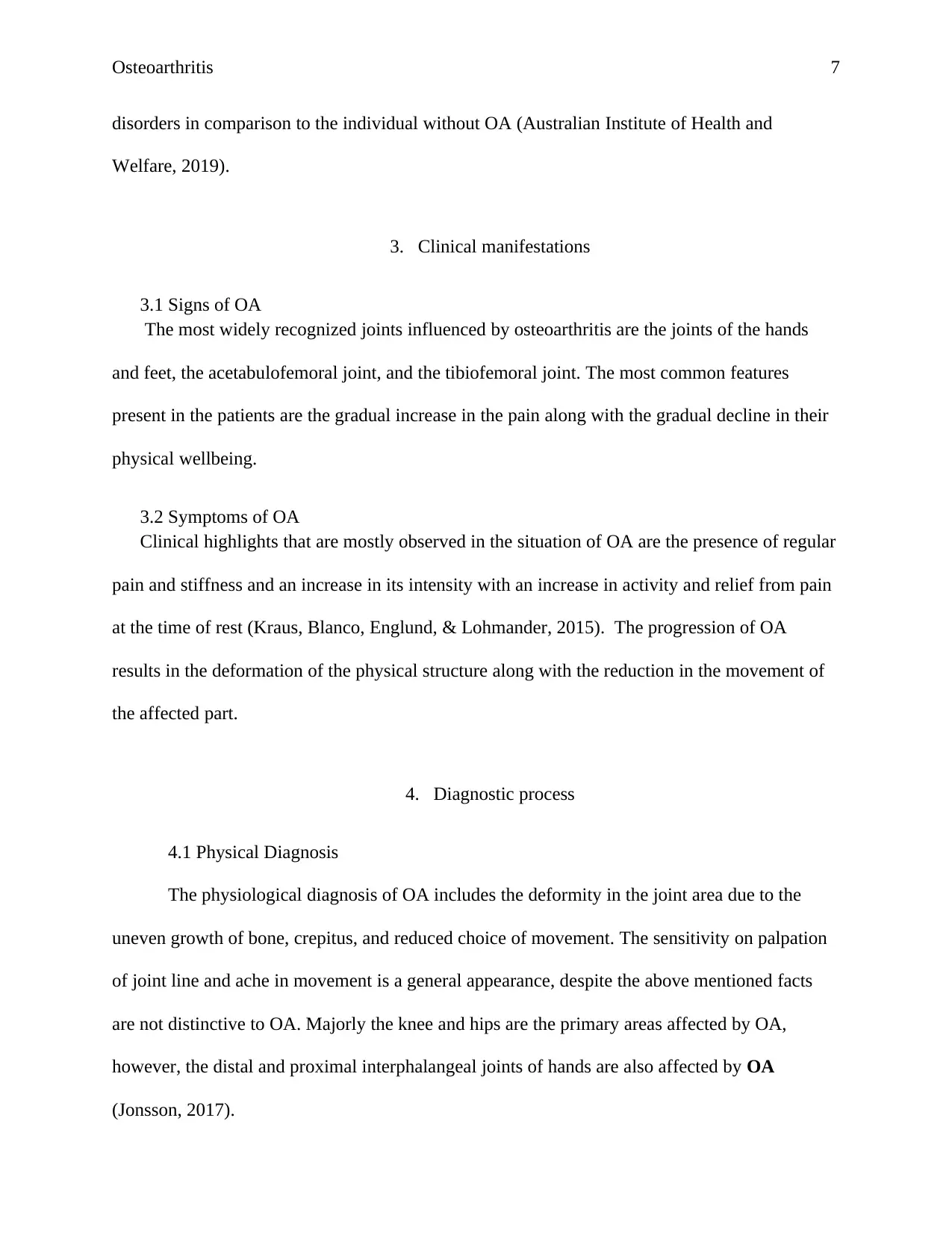
Osteoarthritis 7
disorders in comparison to the individual without OA (Australian Institute of Health and
Welfare, 2019).
3. Clinical manifestations
3.1 Signs of OA
The most widely recognized joints influenced by osteoarthritis are the joints of the hands
and feet, the acetabulofemoral joint, and the tibiofemoral joint. The most common features
present in the patients are the gradual increase in the pain along with the gradual decline in their
physical wellbeing.
3.2 Symptoms of OA
Clinical highlights that are mostly observed in the situation of OA are the presence of regular
pain and stiffness and an increase in its intensity with an increase in activity and relief from pain
at the time of rest (Kraus, Blanco, Englund, & Lohmander, 2015). The progression of OA
results in the deformation of the physical structure along with the reduction in the movement of
the affected part.
4. Diagnostic process
4.1 Physical Diagnosis
The physiological diagnosis of OA includes the deformity in the joint area due to the
uneven growth of bone, crepitus, and reduced choice of movement. The sensitivity on palpation
of joint line and ache in movement is a general appearance, despite the above mentioned facts
are not distinctive to OA. Majorly the knee and hips are the primary areas affected by OA,
however, the distal and proximal interphalangeal joints of hands are also affected by OA
(Jonsson, 2017).
disorders in comparison to the individual without OA (Australian Institute of Health and
Welfare, 2019).
3. Clinical manifestations
3.1 Signs of OA
The most widely recognized joints influenced by osteoarthritis are the joints of the hands
and feet, the acetabulofemoral joint, and the tibiofemoral joint. The most common features
present in the patients are the gradual increase in the pain along with the gradual decline in their
physical wellbeing.
3.2 Symptoms of OA
Clinical highlights that are mostly observed in the situation of OA are the presence of regular
pain and stiffness and an increase in its intensity with an increase in activity and relief from pain
at the time of rest (Kraus, Blanco, Englund, & Lohmander, 2015). The progression of OA
results in the deformation of the physical structure along with the reduction in the movement of
the affected part.
4. Diagnostic process
4.1 Physical Diagnosis
The physiological diagnosis of OA includes the deformity in the joint area due to the
uneven growth of bone, crepitus, and reduced choice of movement. The sensitivity on palpation
of joint line and ache in movement is a general appearance, despite the above mentioned facts
are not distinctive to OA. Majorly the knee and hips are the primary areas affected by OA,
however, the distal and proximal interphalangeal joints of hands are also affected by OA
(Jonsson, 2017).
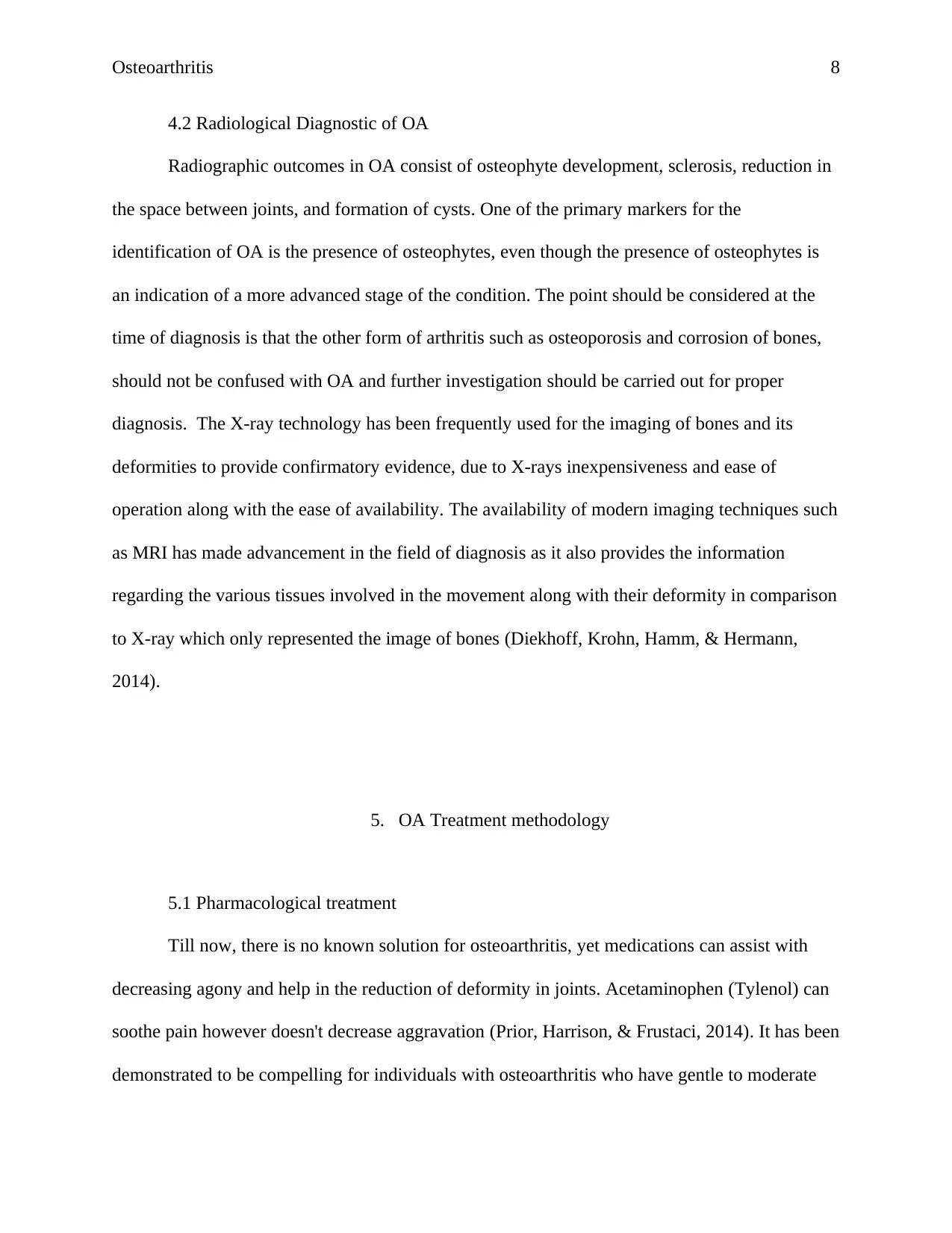
Osteoarthritis 8
4.2 Radiological Diagnostic of OA
Radiographic outcomes in OA consist of osteophyte development, sclerosis, reduction in
the space between joints, and formation of cysts. One of the primary markers for the
identification of OA is the presence of osteophytes, even though the presence of osteophytes is
an indication of a more advanced stage of the condition. The point should be considered at the
time of diagnosis is that the other form of arthritis such as osteoporosis and corrosion of bones,
should not be confused with OA and further investigation should be carried out for proper
diagnosis. The X-ray technology has been frequently used for the imaging of bones and its
deformities to provide confirmatory evidence, due to X-rays inexpensiveness and ease of
operation along with the ease of availability. The availability of modern imaging techniques such
as MRI has made advancement in the field of diagnosis as it also provides the information
regarding the various tissues involved in the movement along with their deformity in comparison
to X-ray which only represented the image of bones (Diekhoff, Krohn, Hamm, & Hermann,
2014).
5. OA Treatment methodology
5.1 Pharmacological treatment
Till now, there is no known solution for osteoarthritis, yet medications can assist with
decreasing agony and help in the reduction of deformity in joints. Acetaminophen (Tylenol) can
soothe pain however doesn't decrease aggravation (Prior, Harrison, & Frustaci, 2014). It has been
demonstrated to be compelling for individuals with osteoarthritis who have gentle to moderate
4.2 Radiological Diagnostic of OA
Radiographic outcomes in OA consist of osteophyte development, sclerosis, reduction in
the space between joints, and formation of cysts. One of the primary markers for the
identification of OA is the presence of osteophytes, even though the presence of osteophytes is
an indication of a more advanced stage of the condition. The point should be considered at the
time of diagnosis is that the other form of arthritis such as osteoporosis and corrosion of bones,
should not be confused with OA and further investigation should be carried out for proper
diagnosis. The X-ray technology has been frequently used for the imaging of bones and its
deformities to provide confirmatory evidence, due to X-rays inexpensiveness and ease of
operation along with the ease of availability. The availability of modern imaging techniques such
as MRI has made advancement in the field of diagnosis as it also provides the information
regarding the various tissues involved in the movement along with their deformity in comparison
to X-ray which only represented the image of bones (Diekhoff, Krohn, Hamm, & Hermann,
2014).
5. OA Treatment methodology
5.1 Pharmacological treatment
Till now, there is no known solution for osteoarthritis, yet medications can assist with
decreasing agony and help in the reduction of deformity in joints. Acetaminophen (Tylenol) can
soothe pain however doesn't decrease aggravation (Prior, Harrison, & Frustaci, 2014). It has been
demonstrated to be compelling for individuals with osteoarthritis who have gentle to moderate
⊘ This is a preview!⊘
Do you want full access?
Subscribe today to unlock all pages.

Trusted by 1+ million students worldwide
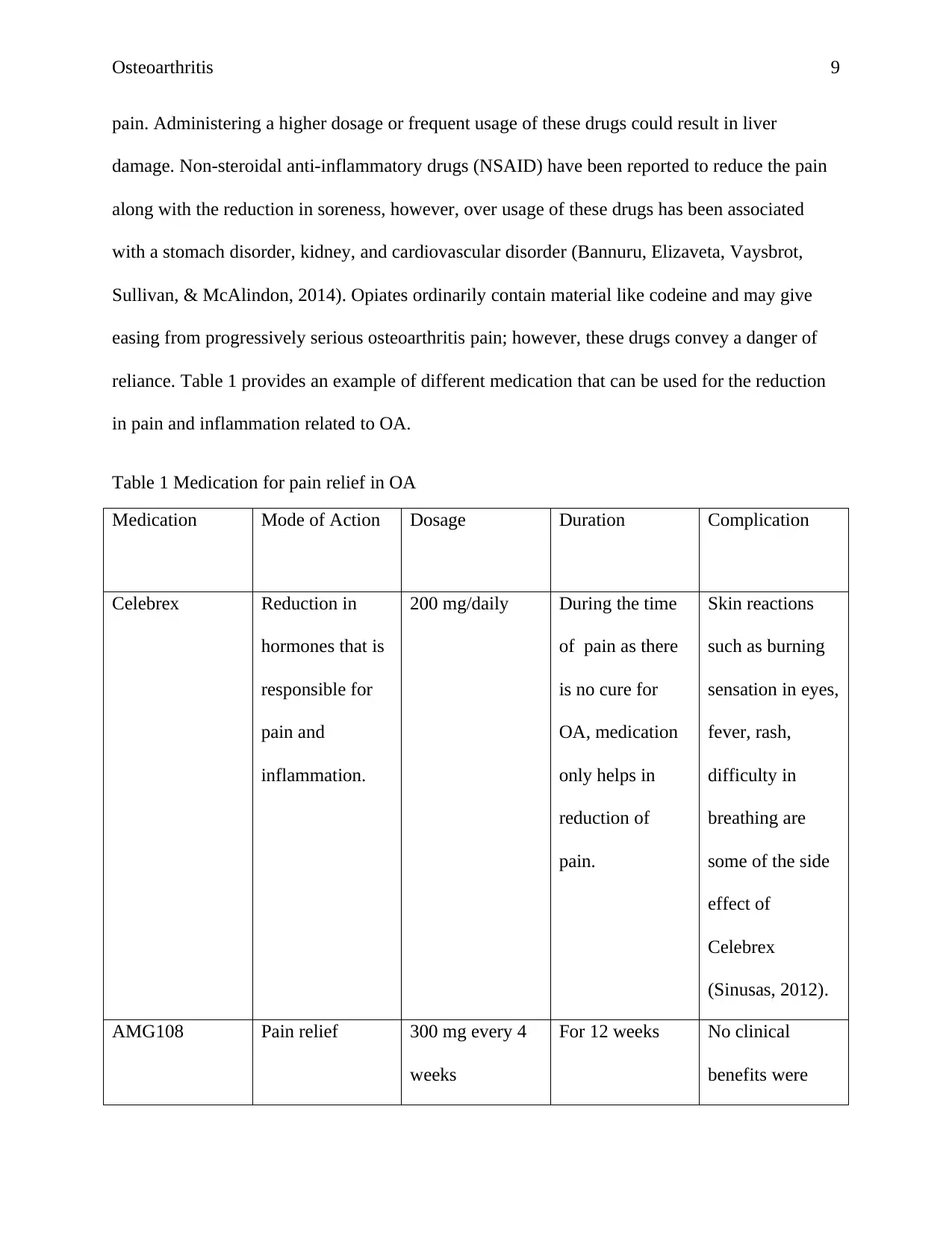
Osteoarthritis 9
pain. Administering a higher dosage or frequent usage of these drugs could result in liver
damage. Non-steroidal anti-inflammatory drugs (NSAID) have been reported to reduce the pain
along with the reduction in soreness, however, over usage of these drugs has been associated
with a stomach disorder, kidney, and cardiovascular disorder (Bannuru, Elizaveta, Vaysbrot,
Sullivan, & McAlindon, 2014). Opiates ordinarily contain material like codeine and may give
easing from progressively serious osteoarthritis pain; however, these drugs convey a danger of
reliance. Table 1 provides an example of different medication that can be used for the reduction
in pain and inflammation related to OA.
Table 1 Medication for pain relief in OA
Medication Mode of Action Dosage Duration Complication
Celebrex Reduction in
hormones that is
responsible for
pain and
inflammation.
200 mg/daily During the time
of pain as there
is no cure for
OA, medication
only helps in
reduction of
pain.
Skin reactions
such as burning
sensation in eyes,
fever, rash,
difficulty in
breathing are
some of the side
effect of
Celebrex
(Sinusas, 2012).
AMG108 Pain relief 300 mg every 4
weeks
For 12 weeks No clinical
benefits were
pain. Administering a higher dosage or frequent usage of these drugs could result in liver
damage. Non-steroidal anti-inflammatory drugs (NSAID) have been reported to reduce the pain
along with the reduction in soreness, however, over usage of these drugs has been associated
with a stomach disorder, kidney, and cardiovascular disorder (Bannuru, Elizaveta, Vaysbrot,
Sullivan, & McAlindon, 2014). Opiates ordinarily contain material like codeine and may give
easing from progressively serious osteoarthritis pain; however, these drugs convey a danger of
reliance. Table 1 provides an example of different medication that can be used for the reduction
in pain and inflammation related to OA.
Table 1 Medication for pain relief in OA
Medication Mode of Action Dosage Duration Complication
Celebrex Reduction in
hormones that is
responsible for
pain and
inflammation.
200 mg/daily During the time
of pain as there
is no cure for
OA, medication
only helps in
reduction of
pain.
Skin reactions
such as burning
sensation in eyes,
fever, rash,
difficulty in
breathing are
some of the side
effect of
Celebrex
(Sinusas, 2012).
AMG108 Pain relief 300 mg every 4
weeks
For 12 weeks No clinical
benefits were
Paraphrase This Document
Need a fresh take? Get an instant paraphrase of this document with our AI Paraphraser
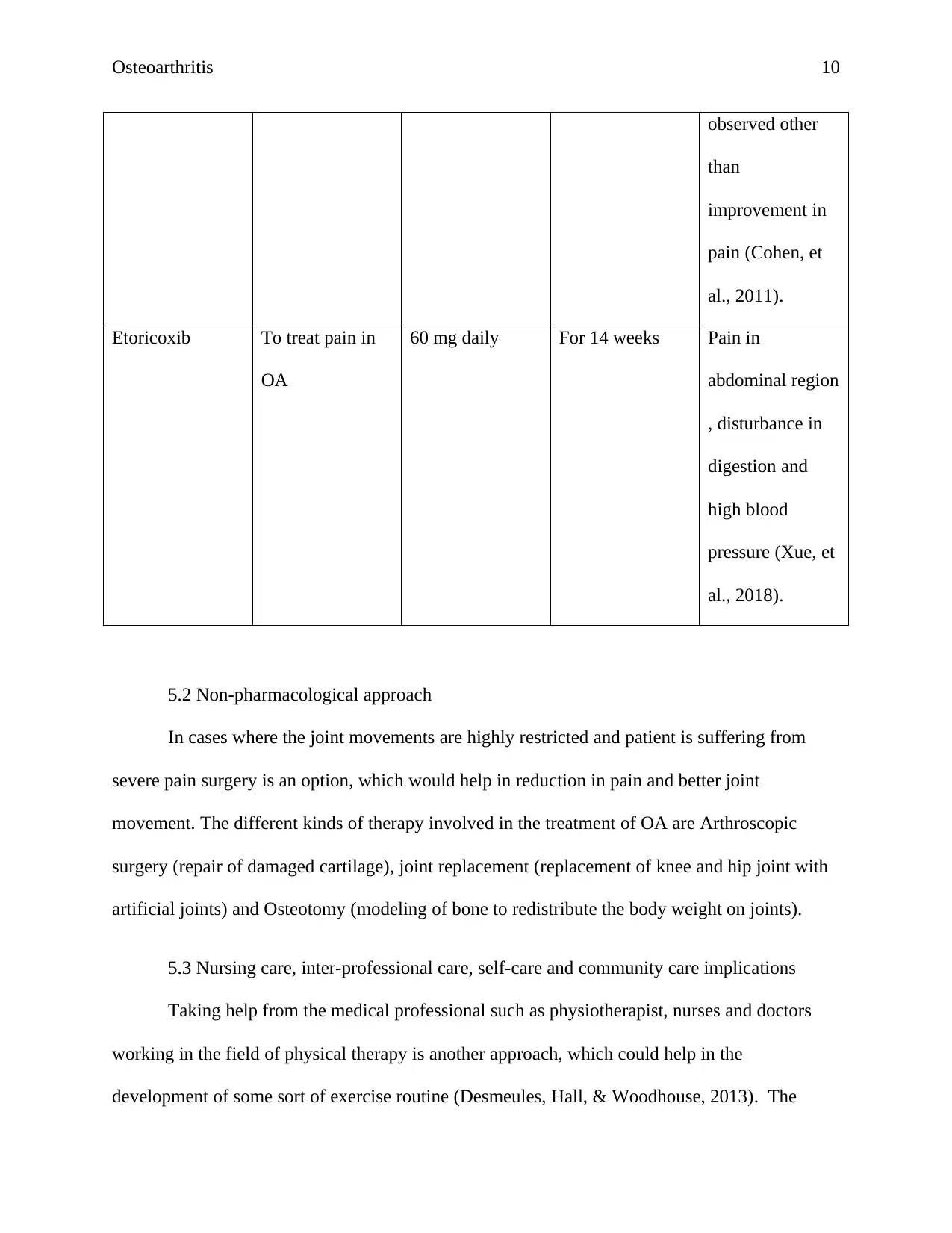
Osteoarthritis 10
observed other
than
improvement in
pain (Cohen, et
al., 2011).
Etoricoxib To treat pain in
OA
60 mg daily For 14 weeks Pain in
abdominal region
, disturbance in
digestion and
high blood
pressure (Xue, et
al., 2018).
5.2 Non-pharmacological approach
In cases where the joint movements are highly restricted and patient is suffering from
severe pain surgery is an option, which would help in reduction in pain and better joint
movement. The different kinds of therapy involved in the treatment of OA are Arthroscopic
surgery (repair of damaged cartilage), joint replacement (replacement of knee and hip joint with
artificial joints) and Osteotomy (modeling of bone to redistribute the body weight on joints).
5.3 Nursing care, inter-professional care, self-care and community care implications
Taking help from the medical professional such as physiotherapist, nurses and doctors
working in the field of physical therapy is another approach, which could help in the
development of some sort of exercise routine (Desmeules, Hall, & Woodhouse, 2013). The
observed other
than
improvement in
pain (Cohen, et
al., 2011).
Etoricoxib To treat pain in
OA
60 mg daily For 14 weeks Pain in
abdominal region
, disturbance in
digestion and
high blood
pressure (Xue, et
al., 2018).
5.2 Non-pharmacological approach
In cases where the joint movements are highly restricted and patient is suffering from
severe pain surgery is an option, which would help in reduction in pain and better joint
movement. The different kinds of therapy involved in the treatment of OA are Arthroscopic
surgery (repair of damaged cartilage), joint replacement (replacement of knee and hip joint with
artificial joints) and Osteotomy (modeling of bone to redistribute the body weight on joints).
5.3 Nursing care, inter-professional care, self-care and community care implications
Taking help from the medical professional such as physiotherapist, nurses and doctors
working in the field of physical therapy is another approach, which could help in the
development of some sort of exercise routine (Desmeules, Hall, & Woodhouse, 2013). The
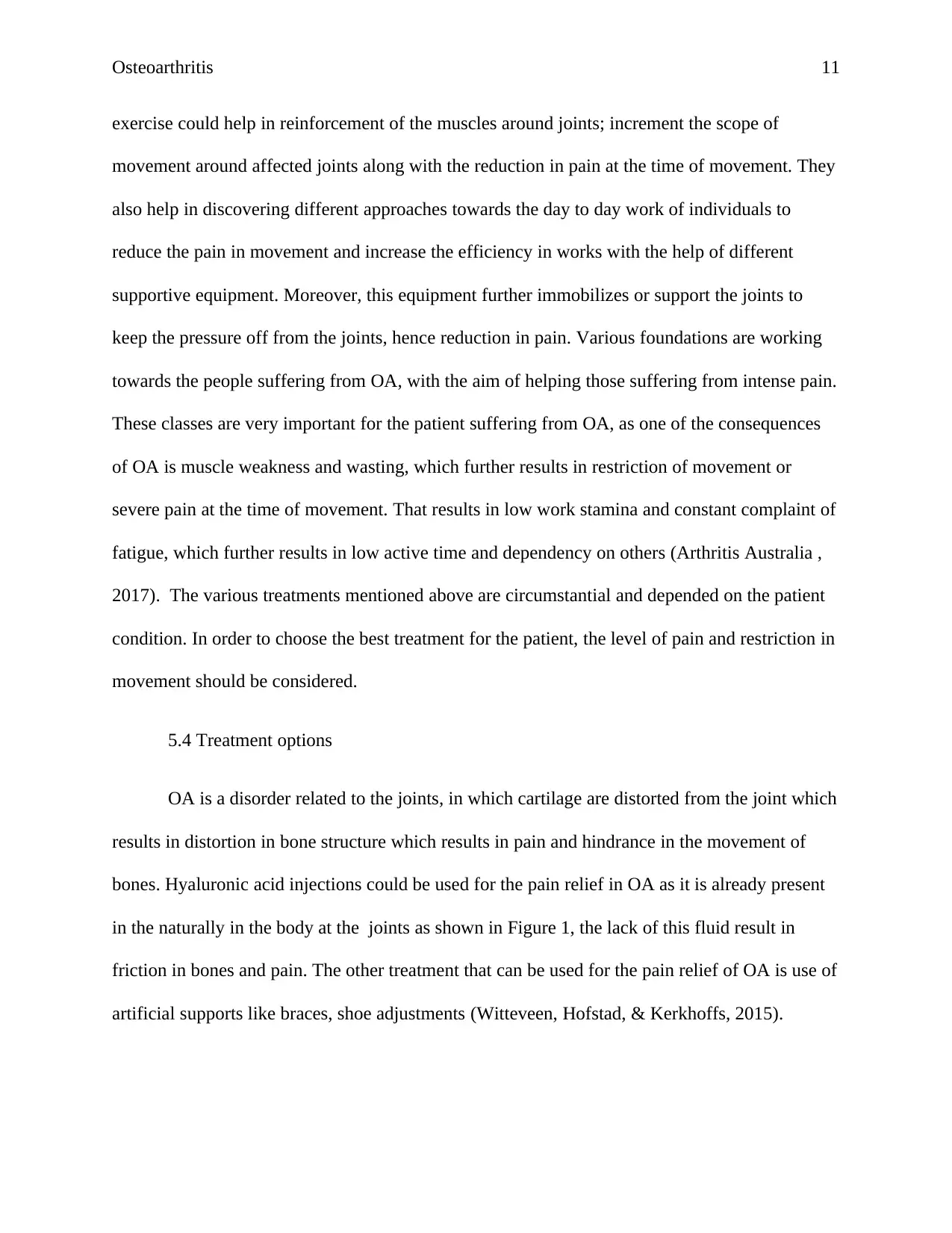
Osteoarthritis 11
exercise could help in reinforcement of the muscles around joints; increment the scope of
movement around affected joints along with the reduction in pain at the time of movement. They
also help in discovering different approaches towards the day to day work of individuals to
reduce the pain in movement and increase the efficiency in works with the help of different
supportive equipment. Moreover, this equipment further immobilizes or support the joints to
keep the pressure off from the joints, hence reduction in pain. Various foundations are working
towards the people suffering from OA, with the aim of helping those suffering from intense pain.
These classes are very important for the patient suffering from OA, as one of the consequences
of OA is muscle weakness and wasting, which further results in restriction of movement or
severe pain at the time of movement. That results in low work stamina and constant complaint of
fatigue, which further results in low active time and dependency on others (Arthritis Australia ,
2017). The various treatments mentioned above are circumstantial and depended on the patient
condition. In order to choose the best treatment for the patient, the level of pain and restriction in
movement should be considered.
5.4 Treatment options
OA is a disorder related to the joints, in which cartilage are distorted from the joint which
results in distortion in bone structure which results in pain and hindrance in the movement of
bones. Hyaluronic acid injections could be used for the pain relief in OA as it is already present
in the naturally in the body at the joints as shown in Figure 1, the lack of this fluid result in
friction in bones and pain. The other treatment that can be used for the pain relief of OA is use of
artificial supports like braces, shoe adjustments (Witteveen, Hofstad, & Kerkhoffs, 2015).
exercise could help in reinforcement of the muscles around joints; increment the scope of
movement around affected joints along with the reduction in pain at the time of movement. They
also help in discovering different approaches towards the day to day work of individuals to
reduce the pain in movement and increase the efficiency in works with the help of different
supportive equipment. Moreover, this equipment further immobilizes or support the joints to
keep the pressure off from the joints, hence reduction in pain. Various foundations are working
towards the people suffering from OA, with the aim of helping those suffering from intense pain.
These classes are very important for the patient suffering from OA, as one of the consequences
of OA is muscle weakness and wasting, which further results in restriction of movement or
severe pain at the time of movement. That results in low work stamina and constant complaint of
fatigue, which further results in low active time and dependency on others (Arthritis Australia ,
2017). The various treatments mentioned above are circumstantial and depended on the patient
condition. In order to choose the best treatment for the patient, the level of pain and restriction in
movement should be considered.
5.4 Treatment options
OA is a disorder related to the joints, in which cartilage are distorted from the joint which
results in distortion in bone structure which results in pain and hindrance in the movement of
bones. Hyaluronic acid injections could be used for the pain relief in OA as it is already present
in the naturally in the body at the joints as shown in Figure 1, the lack of this fluid result in
friction in bones and pain. The other treatment that can be used for the pain relief of OA is use of
artificial supports like braces, shoe adjustments (Witteveen, Hofstad, & Kerkhoffs, 2015).
⊘ This is a preview!⊘
Do you want full access?
Subscribe today to unlock all pages.

Trusted by 1+ million students worldwide
1 out of 18
Related Documents
Your All-in-One AI-Powered Toolkit for Academic Success.
+13062052269
info@desklib.com
Available 24*7 on WhatsApp / Email
![[object Object]](/_next/static/media/star-bottom.7253800d.svg)
Unlock your academic potential
Copyright © 2020–2025 A2Z Services. All Rights Reserved. Developed and managed by ZUCOL.





